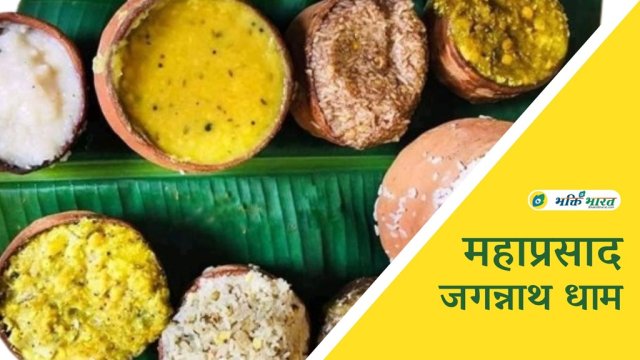Make Bhakti Bharat Your Preferred Source on Google

Why is the Mahaprasad of Bhagwan Jagannath prepared in an earthen pot (भगवान जगन्नाथ का महाप्रसाद मिट्टी के बर्तन में क्यों बनाया जाता है?)

Every year Jagannath Rath Yatra is taken out with great pomp. Devotees come from every corner of the country to participate in it. According to the calendar, the Rath Yatra of Bhagwan Jagannath is taken out on the second day of Shukla Paksha of Ashadh month and it ends on the eleventh day of Shukla Paksha. Therefore, preparations start several months in advance. This festival lasts for a total of 10 days. The Prasad of the temple of Bhagwan Jagannath has its own distinct specialty.The food offered in the temple of Jagannath Puri is called Mahaprasad. Devotees come from far and wide to receive it. These offerings vary from place to place. The kitchen located in Jagannath temple is also called the largest kitchen in the world. Here 56 offerings are also prepared for Bhagwan Jagannath.
Now in such a situation, there is a question in the mind that why God's Mahaprasad is made only in earthen pots.
Earthen pot is a symbol of purity
Soil is considered a sacred element. In Hinduism, soil is considered a symbol of the goddess Earth, the source of life and prosperity. Soil is a symbol of nature, and Jagannath ji is associated with nature. By making symbols in earthen pots, devotees express their gratitude towards nature. Earthen pots are a symbol of simplicity and humility. Jagannath ji is considered equal to all the devotees, and the icon made in earthen pot reflects this sentiment. Therefore the icon of Bhagwan Jagannath is made in an earthen pot.
Earthen pot is a symbol of auspiciousness
In Hinduism, soil is considered a symbol of the goddess Earth, the source of life and prosperity. Not only this, Mahaprasad made in earthen pots is very dear to Bhagwan Jagannath. Therefore, Mahaprasad of Bhagwan Jagannath is made in earthen pots.
Mahaprasad is made in the world's largest kitchen
The kitchen located in Jagannath temple is said to be the largest kitchen in the world. There are 240 stoves made of mud and brick. Along with this, 500 cooks along with 300 colleagues prepare 56 bhog. The process of making Bhog here is also different. Here 9 utensils are kept one above the other on the stove. Which also represents Navagraha, 9 grains and Navadurga. The special thing is that the food gets cooked first in the vessel placed above.
Now in such a situation, there is a question in the mind that why God's Mahaprasad is made only in earthen pots.
Earthen pot is a symbol of purity
Soil is considered a sacred element. In Hinduism, soil is considered a symbol of the goddess Earth, the source of life and prosperity. Soil is a symbol of nature, and Jagannath ji is associated with nature. By making symbols in earthen pots, devotees express their gratitude towards nature. Earthen pots are a symbol of simplicity and humility. Jagannath ji is considered equal to all the devotees, and the icon made in earthen pot reflects this sentiment. Therefore the icon of Bhagwan Jagannath is made in an earthen pot.
Earthen pot is a symbol of auspiciousness
In Hinduism, soil is considered a symbol of the goddess Earth, the source of life and prosperity. Not only this, Mahaprasad made in earthen pots is very dear to Bhagwan Jagannath. Therefore, Mahaprasad of Bhagwan Jagannath is made in earthen pots.
Mahaprasad is made in the world's largest kitchen
The kitchen located in Jagannath temple is said to be the largest kitchen in the world. There are 240 stoves made of mud and brick. Along with this, 500 cooks along with 300 colleagues prepare 56 bhog. The process of making Bhog here is also different. Here 9 utensils are kept one above the other on the stove. Which also represents Navagraha, 9 grains and Navadurga. The special thing is that the food gets cooked first in the vessel placed above.
भगवान जगन्नाथ का महाप्रसाद मिट्टी के बर्तन में क्यों बनाया जाता है? हिन्दी में पढ़ें
जगन्नाथ मंदिर में स्थित रसोई को दुनिया की सबसे बड़ी रसोई भी कहा जाता है। यहां भगवान जगन्नाथ के लिए 56 भोग का प्रसाद भी बनाया जाता है।Read Also
- Corona Quarantine Alike Bhagwan Jagannath Anasara
- Top Famous Temples Of Jagannath Puri Odisha
- Jagannath Temple Celebrating Rath Yatra Mahostav In Delhi Ncr
- Top Famous Temples Of Bhubaneswar Odisha
- Jagannath Mangal Aarti
- Shri Jagganath Sandhya Aarti
- Why Is Jagannath Temple Prasad Called Mahaprasad
Blogs Bhagwan Jagannath BlogsRath Yatra BlogsEarthen Pot BlogsJagannath Puri BlogsAnasara BlogsSnan Yatra BlogsBathing Festival Blogs
If you love this blogs please like, share or comment!
 Follow Bhakti Bharat Whatsapp Channel »
Follow Bhakti Bharat Whatsapp Channel »
Bookmark / Save this blogs for future
* Please share any of your suggestions or ideas with us.
 Follow Bhakti Bharat Whatsapp Channel »
Follow Bhakti Bharat Whatsapp Channel »Bookmark / Save this blogs for future
* Please share any of your suggestions or ideas with us.
** Please write your any type of feedback or suggestion(s) on our contact us page. Whatever you think, (+) or (-) doesn't metter!
Quick Links:
- Famous Mata temple of Delhi NCR
- Famous Kali Temple in Delhi NCR
- Char Dham
- 12 Jyotirlinga
- Sapta Moksha Puri
- Famous and Popular Temples in Brajbhoomi
- List Of ISKCON Temples
- Famous Birla Temples
- Delhi's Famous Temple of the Mahabharat
- Famous Shiv Mandir in Delhi NCR
- Famous Hanuman Balaji Mandir of Delhi
- Famous Temples in Delhi, Ghaziabad, Noida and Gurugram
- Top Famous Temple of Sirsaganj




